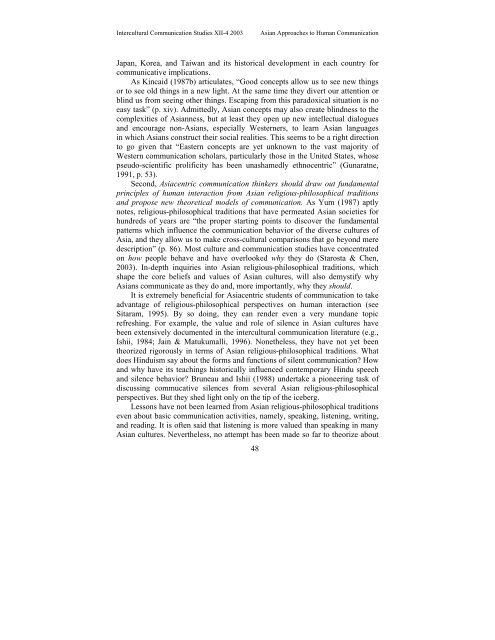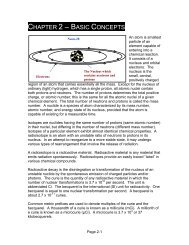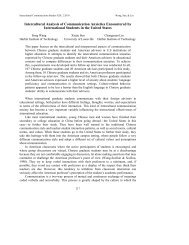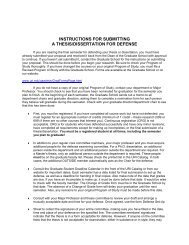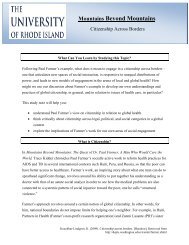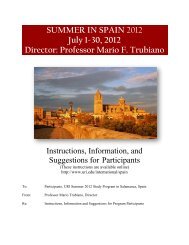asian approaches to human communication - University of Rhode ...
asian approaches to human communication - University of Rhode ...
asian approaches to human communication - University of Rhode ...
Create successful ePaper yourself
Turn your PDF publications into a flip-book with our unique Google optimized e-Paper software.
Intercultural Communication Studies XII-4 2003 Asian Approaches <strong>to</strong> Human Communication<br />
Japan, Korea, and Taiwan and its his<strong>to</strong>rical development in each country for<br />
communicative implications.<br />
As Kincaid (1987b) articulates, “Good concepts allow us <strong>to</strong> see new things<br />
or <strong>to</strong> see old things in a new light. At the same time they divert our attention or<br />
blind us from seeing other things. Escaping from this paradoxical situation is no<br />
easy task” (p. xiv). Admittedly, Asian concepts may also create blindness <strong>to</strong> the<br />
complexities <strong>of</strong> Asianness, but at least they open up new intellectual dialogues<br />
and encourage non-Asians, especially Westerners, <strong>to</strong> learn Asian languages<br />
in which Asians construct their social realities. This seems <strong>to</strong> be a right direction<br />
<strong>to</strong> go given that “Eastern concepts are yet unknown <strong>to</strong> the vast majority <strong>of</strong><br />
Western <strong>communication</strong> scholars, particularly those in the United States, whose<br />
pseudo-scientific prolificity has been unashamedly ethnocentric” (Gunaratne,<br />
1991, p. 53).<br />
Second, Asiacentric <strong>communication</strong> thinkers should draw out fundamental<br />
principles <strong>of</strong> <strong>human</strong> interaction from Asian religious-philosophical traditions<br />
and propose new theoretical models <strong>of</strong> <strong>communication</strong>. As Yum (1987) aptly<br />
notes, religious-philosophical traditions that have permeated Asian societies for<br />
hundreds <strong>of</strong> years are “the proper starting points <strong>to</strong> discover the fundamental<br />
patterns which influence the <strong>communication</strong> behavior <strong>of</strong> the diverse cultures <strong>of</strong><br />
Asia, and they allow us <strong>to</strong> make cross-cultural comparisons that go beyond mere<br />
description” (p. 86). Most culture and <strong>communication</strong> studies have concentrated<br />
on how people behave and have overlooked why they do (Starosta & Chen,<br />
2003). In-depth inquiries in<strong>to</strong> Asian religious-philosophical traditions, which<br />
shape the core beliefs and values <strong>of</strong> Asian cultures, will also demystify why<br />
Asians communicate as they do and, more importantly, why they should.<br />
It is extremely beneficial for Asiacentric students <strong>of</strong> <strong>communication</strong> <strong>to</strong> take<br />
advantage <strong>of</strong> religious-philosophical perspectives on <strong>human</strong> interaction (see<br />
Sitaram, 1995). By so doing, they can render even a very mundane <strong>to</strong>pic<br />
refreshing. For example, the value and role <strong>of</strong> silence in Asian cultures have<br />
been extensively documented in the intercultural <strong>communication</strong> literature (e.g.,<br />
Ishii, 1984; Jain & Matukumalli, 1996). Nonetheless, they have not yet been<br />
theorized rigorously in terms <strong>of</strong> Asian religious-philosophical traditions. What<br />
does Hinduism say about the forms and functions <strong>of</strong> silent <strong>communication</strong>? How<br />
and why have its teachings his<strong>to</strong>rically influenced contemporary Hindu speech<br />
and silence behavior? Bruneau and Ishii (1988) undertake a pioneering task <strong>of</strong><br />
discussing commucative silences from several Asian religious-philosophical<br />
perspectives. But they shed light only on the tip <strong>of</strong> the iceberg.<br />
Lessons have not been learned from Asian religious-philosophical traditions<br />
even about basic <strong>communication</strong> activities, namely, speaking, listening, writing,<br />
and reading. It is <strong>of</strong>ten said that listening is more valued than speaking in many<br />
Asian cultures. Nevertheless, no attempt has been made so far <strong>to</strong> theorize about<br />
48


